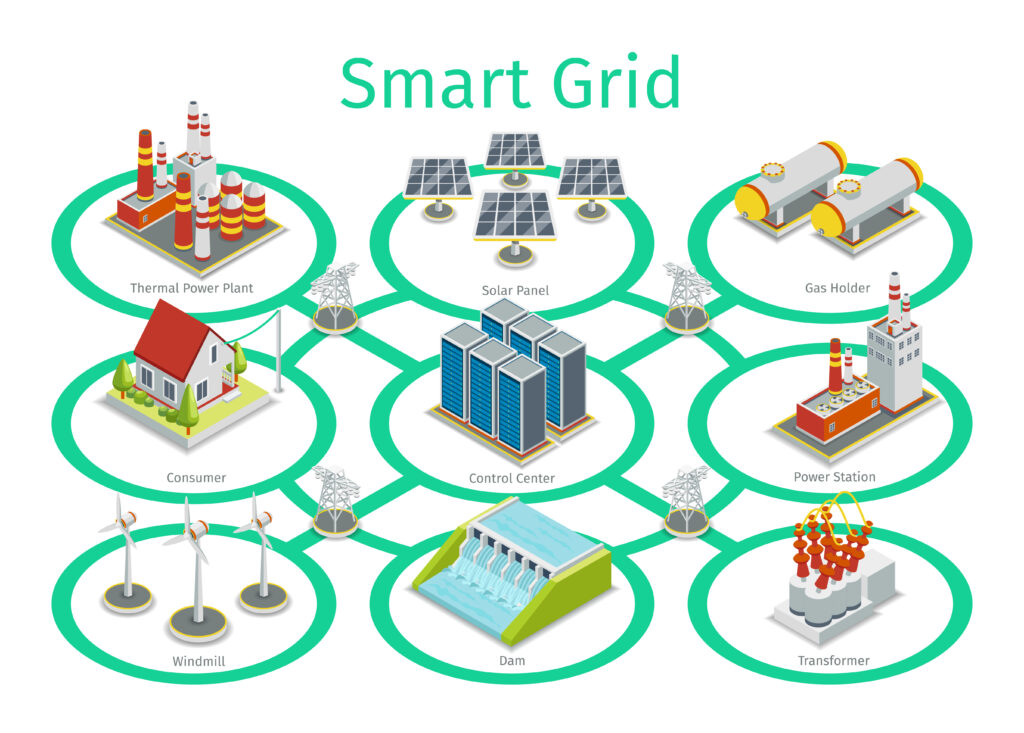
Table of Contents
Introduction
Welcome to a world where traditional power grids are revolutionized into smart grids, paving the way for a dynamic and eco-friendly energy ecosystem. In this blog, we will explore 10 innovative strategies that unlock the true potential of smart grids, leading us towards a greener and more sustainable future.
Embrace Smart Metering
Smart grids start with smart meters. These advanced devices provide real-time data on energy consumption, empowering users to make informed decisions about their energy usage. By optimizing energy consumption, we can reduce waste and enhance overall efficiency. Smart metering enables individuals to monitor their energy usage patterns, identify areas of improvement, and adjust their behaviors accordingly. This leads to more energy-conscious choices and a reduction in unnecessary consumption, contributing to a greener future.
Answering the Call: Demand Response Programs
Demand response programs empower individuals to actively participate in the grid’s stability. During peak demand periods, participants voluntarily reduce their energy consumption, alleviating strain on the grid and minimizing the need for additional power generation. By adjusting energy usage when it matters most, consumers contribute to a more sustainable energy system. Demand response programs incentivize individuals to be mindful of their energy consumption and make a positive impact on the environment while enjoying potential cost savings.
Empowering Local Energy Generation: Distributed Energy Resources (DERs)
Smart grids embrace the power of distributed energy resources (DERs) such as solar panels, wind turbines, and small-scale power generation systems. By integrating these resources into the grid, we reduce transmission losses and increase the utilization of renewable energy sources. DERs enable individuals and communities to become energy producers, fostering a sense of energy independence and promoting the adoption of green technologies. By generating power locally, we reduce our dependence on centralized fossil fuel-based power plants, leading to a cleaner and more sustainable energy landscape.
Storing Energy for the Future: Energy Storage Integration
Energy storage is a vital component of a smart grid system. By utilizing battery technology and other energy storage solutions, we can balance the supply and demand of electricity. Energy storage systems help to mitigate fluctuations in renewable energy generation, ensuring a reliable and consistent power supply. They also play a crucial role in maximizing the utilization of renewable energy sources by storing excess energy generated during peak production periods and making it available during periods of high demand or low generation. Energy storage integration allows for a more efficient and flexible grid, reducing reliance on traditional backup power sources.
Real-Time Insights: Monitoring and Analytics
Smart grids utilize advanced sensors and monitoring devices to collect real-time data on grid performance. This enables utility companies to identify inefficiencies, detect faults, and optimize grid performance. With access to comprehensive data, decision-makers can make informed decisions, leading to reduced energy losses, improved reliability, and enhanced operational efficiency. Monitoring and analytics empower grid operators to proactively address issues, predict and prevent potential problems, and optimize the overall performance of the grid. Real-time insights enable better resource allocation and facilitate continuous improvements in energy management.
Time-Driven Savings: Dynamic Pricing
Smart grids introduce dynamic pricing models that reflect the actual cost of electricity production. By implementing time-of-use pricing, where electricity prices fluctuate based on demand and supply conditions, consumers can adjust their energy usage to off-peak hours when electricity is cheaper. Dynamic pricing incentivizes load shifting, reducing strain on the grid during peak demand periods and maximizing the utilization of renewable energy sources. It also encourages energy-conscious behavior by providing price signals that promote energy efficiency and sustainability. Consumers can save money while contributing to a greener and more balanced energy system.
Automation for Efficiency and Resilience
Automation and self-healing capabilities are integral to smart grid systems. By deploying intelligent automation technologies, smart grids can quickly detect and isolate faults or outages, reroute power, and restore service without manual intervention. Automation enhances operational efficiency, reduces downtime, and improves the overall performance of the grid. Self-healing capabilities minimize the duration and impact of disruptions, ensuring a more resilient and reliable energy infrastructure. By leveraging automation, smart grids can adapt to changing conditions, optimize resource allocation, and provide a robust and responsive energy system.
Driving Electric: Electric Vehicle Integration
The rise of electric vehicles (EVs) presents both opportunities and challenges for the grid. Smart grids play a crucial role in managing EV charging and optimizing it to align with low-demand or high-renewable energy periods. By integrating EV charging infrastructure into the grid, we reduce the strain on the energy infrastructure and maximize the utilization of renewable energy sources for transportation. Electric vehicle integration promotes greener transportation options, reduces carbon emissions, and contributes to the overall sustainability of the energy system.
Strengthening Grid Security
As smart grids become more interconnected, robust cybersecurity measures are crucial. Grid security encompasses encryption, authentication, and intrusion detection systems to protect against potential cyber threats. Safeguarding the integrity and reliability of the grid is paramount to ensuring a resilient and secure energy infrastructure. By implementing comprehensive security protocols, smart grids can mitigate risks, protect against cyber-attacks, and maintain public trust. A secure grid enables the efficient and reliable delivery of energy, ensuring the continuous operation of critical services and supporting the transition to a greener future.
Empowering Energy Consciousness
Consumer engagement and education are essential for the success of smart grid initiatives. By providing real-time energy data, promoting energy-conscious behaviors, and fostering awareness, we empower individuals to actively participate in the transition towards a greener future. Energy-conscious consumers are more likely to make sustainable choices, adopt energy-saving practices, and invest in energy-efficient technologies. Through education and engagement, we can cultivate a culture of energy consciousness, where individuals understand the importance of their energy choices and contribute to a more sustainable and resilient energy system.
Conclusion
Smart grids hold immense potential to transform our energy landscape, offering innovative strategies for a greener and more sustainable future. By embracing these strategies, from smart metering to demand response programs, distributed energy resources, and more, we can unlock the full power of smart grids and drive positive change towards a cleaner and more efficient energy system.
FAQ
1: What is a smart grid?
A smart grid is an advanced electricity distribution system that uses digital technologies to optimize energy generation, distribution, and consumption. It integrates features like smart meters, real-time monitoring, and renewable energy integration to enhance efficiency and sustainability.
2: How do smart grids contribute to a greener future?
Smart grids enable energy optimization, demand response programs, and integration of renewable energy sources like solar and wind. By reducing waste, promoting clean energy, and empowering consumers to make sustainable choices, smart grids play a crucial role in achieving a greener future.
3: What are some strategies for unleashing the power of smart grids?
Strategies for smart grid optimization include smart metering, demand response programs, distributed energy resources (DERs), energy storage integration, real-time monitoring, automation, dynamic pricing, electric vehicle integration, grid security, and consumer engagement and education. These strategies drive efficiency, reliability, and sustainability in the energy system.
4: How do demand response programs work?
Demand response programs encourage consumers to reduce their energy usage during peak demand periods. Participants voluntarily adjust their energy consumption in response to signals or incentives provided by utility companies. By shifting or reducing energy usage during times of high demand, consumers help balance the grid, minimize strain on the system, and contribute to a more sustainable energy future.
5: What is the role of consumer engagement in smart grid success?
Consumer engagement is vital for the success of smart grids. By providing real-time energy data, promoting energy-conscious behaviors, and fostering awareness, consumers become active participants in optimizing their energy consumption. Engaged consumers are more likely to adopt energy-saving practices, invest in energy-efficient technologies, and make informed choices that support a greener and more sustainable energy system. Through education and engagement, consumers play a significant role in driving the success of smart grid initiatives.

